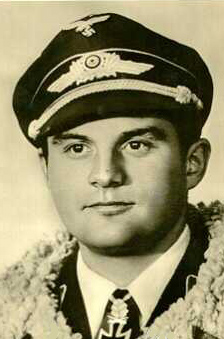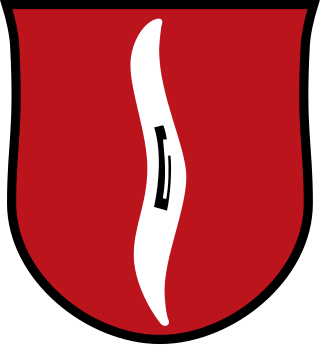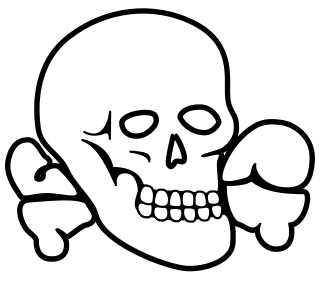
Kampfgeschwader 55 "Greif" was a Luftwaffe bomber unit during World War II. KG 55 was one of the longest serving and well-known in the Luftwaffe. The wing operated the Heinkel He 111 exclusively until 1943, when only two staffeln of its four Gruppen (Groups) used the Junkers Ju 88C.

Joachim Helbig was a German bomber pilot during World War II. He joined the Luftwaffe in 1936, and served almost all of his career with Demonstration Wing 1. With his unit, he participated in the Invasion of Poland, the Norwegian Campaign, the Battles of the Netherlands, Belgium, France and Britain in 1939–40. For his contributions in these campaigns, Helbig received the Knight's Cross of the Iron Cross in late 1940. He was then transferred to the Mediterranean theatre where he bombed Malta, the British Mediterranean Fleet and flew in support of the Afrika Korps. Helbig received the Knight's Cross of the Iron Cross with Oak Leaves and Swords in late 1942 for the support of Field Marshal Erwin Rommel's 1942 summer offensive.
Schlachtgeschwader 2 Immelmann was a Luftwaffe dive-bomber wing of World War II. It was named after Max Immelmann, the first German pilot to earn the Pour le Mérite.

Kampfgeschwader 4 "General Wever" was a Luftwaffe bomber wing during World War II. The unit was formed in May 1939. The unit operated the Dornier Do 17, Junkers Ju 88 and Heinkel He 111 medium bombers, with later service on the Heinkel He 177 heavy bomber. The wing was named after General Walther Wever, the prime pre-war proponent for a strategic bombing capability for the Luftwaffe, who was killed in an aircraft accident in 1936.

Kampfgeschwader 3 "Blitz" (KG 3) was a Luftwaffe bomber wing during World War II.
Paul-Werner Hozzel was a ground attack pilot in the Luftwaffe of Nazi Germany during World War II. He was a recipient of the Knight's Cross of the Iron Cross. Following the war, Hozzel joined the Bundeswehr of West Germany and retired as Brigadegeneral.
Kampfgeschwader 51 "Edelweiss" (KG 51) was a Luftwaffe bomber wing during World War II.

Kampfgeschwader 76 was a Luftwaffe bomber Group during World War II. It was one of the few bomber groups that operated throughout the war.

Kampfgeschwader 54 "Totenkopf" was a Luftwaffe bomber wing during World War II. It served on nearly all the fronts in the European Theatre where the German Luftwaffe operated.

Kampfgeschwader 53 "Legion Condor" was a Luftwaffe bomber wing during World War II. Its units participated on all of the fronts in the European Theatre until it was disbanded in May 1945. At all times it operated the German bomber type Heinkel He 111. Only the 15th (kroat) Squadron of KG 53, established in Agram (Zagreb) July 1942, operated the Dornier Do 17 Z.
Lehrgeschwader 1 formerly Lehrgeschwader Greifswald was a Luftwaffe multi-purpose unit during World War II, operating fighter, bomber and dive-bomber Gruppen. The unit was formed in July 1936 and operated the Messerschmitt Bf 109, Messerschmitt Bf 110, Dornier Do 17, Heinkel He 111, Junkers Ju 88 and Junkers Ju 87.
Kampfgeschwader 77 was a Luftwaffe bomber wing during World War II. Its units participated on all of the major fronts in the European Theatre until its dissolution in 1944. It operated all three of the major German bomber types; the Dornier Do 17, Heinkel He 111 and the Junkers Ju 88.

Hubertus Hitschhold was a German general and ground-attack pilot during World War II. He was a recipient of the Knight's Cross of the Iron Cross with Oak Leaves of Nazi Germany.
Zerstörergeschwader 76 was a Zerstörergeschwader (wing) of the German Luftwaffe during World War II. The wing operated the Messerschmitt Bf 109 in the early phases of World War II, then the Messerschmitt Bf 110 for the duration of the war.

Kampfgeschwader 26 "Löwengeschwader" was a German air force Luftwaffe bomber wing unit during World War II. Its units participated on all of the fronts in the European Theatre until the end of the war. It operated three of the major German aircraft medium bomber types; the Heinkel He 111, Junkers Ju 88 and the Junkers Ju 188. The unit engaged in both strategic bombing, close air support, anti-shipping and aerial interdiction operations. The majority of its operational life – not entirely unlike another Luftwaffe wing designated KG 40 — was spent on anti-shipping missions.

Kampfgeschwader 1 was a German medium bomber wing that operated in the Luftwaffe during World War II.

Zerstörergeschwader 1 was a Luftwaffe zerstörer or ‘destroyer’ wing of World War II.
'Kampfgeschwader' 27 Boelcke was a Luftwaffe medium bomber wing of World War II.
Walter Rudolf Enneccerus was an officer in the Luftwaffe during World War II and a recipient of the Knight's Cross of the Iron Cross.
Zerstörergeschwader 2 was a Luftwaffe heavy/destroyer Fighter Aircraft-wing of World War II.











